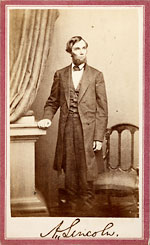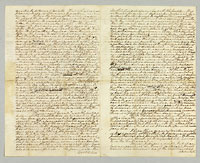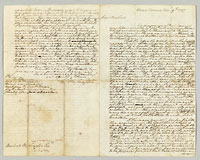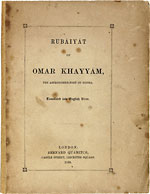Princely Sums for Presidents, the Remaindered Rubáiyát, and Seuss’ Success
The Upstanding Mr. Lincoln
Abraham Lincoln, Signed Carte-de-Visite Photograph, Freeman’s of Philadelphia on January 14, $103,000
The presidential showstopper in the end-of-the-old-year sales was the 1787 Washington letter arguing in favor of the proposed new Constitution that Christie’s New York sold for $3,218,500 on December 4 (see separate report below), but the hefty sum paid for this signed carte-de-visite photograph of Lincoln is something that took these Pennsylvania auctioneers somewhat by surprise in the opening weeks of the new season.
Thomas Le Mere made this portrait of Lincoln at Brady’s Gallery in Washington DC, and collectors of presidential photo trivia will be entranced to learn that of the 119 different photographs of Lincoln now identified, this is one of only 24 in which Abe is shown standing up!
Published in 1863 by E. Anthony of Broadway, this little photocard, measuring just four by two-and-half inches, is a clean and attractive little image, but the saleroom had estimated that $8,000-12,000 might be enough to secure it.
Power to the People
George Washington’s Letter in Support of the Proposed New Constitution, Christie’s New York on December 4, $3,218,500
Billed by the saleroom as the most important Washington letter ever to surface at auction, this letter of November 7, 1787, addressed to his nephew Bushrod, is a closely reasoned and impassioned argument in favor of adopting the proposed new Constitution.
Washington takes on the already strong opposition, which he considers baseless, bogus, and designed only to rouse the emotions of the ignorant and unthinking, and tells Bushrod that in his view, the question of the Constitution boils down to a simple proposition that just about everyone should be competent to decide, “namely–is it best for the States to unite, or not to unite.”
Laying out his case and considering the options and alternatives—even daring to suggest to Bushrod (who was slated to be a member of Virginia’s ratifying convention) that some Virginians have too high an opinion of their own importance—Washington argues that even if the Constitution has imperfections, it can be amended.
“The power under the Constitution will always be with the people. It is entrusted for certain defined purposes and for a certain limited period to representatives of their own chusing; and whenever it is exercised contrary to their interests, or not according to their wishes, their Servants can, and undoubtedly will be, recalled.”
The sum paid set a new auction record for any Washington letter or document. In 2002, again at Christie’s, an account of his experiences in the French & Indian Wars and of Braddock’s defeat sold for $834,500 as part of the Forbes Collection.
Remaindered for Future Glory: “I Blush To See It”
Rubáiyát of Omar Khayyám translated into English verse, Christie’s New York on December 4, $30,000
Famous and honored today, this translation of verses by the eleventh/twelfth-century Persian mathematician, astronomer, physician, philosopher, and poet was once to be found remaindered in the bargain box outside the premises of the famous London bookdealer, Bernard Quaritch—priced at a penny rather than the original one shilling.
Edward Fitzgerald had borne the printing and advertising costs of the edition of 250 copies himself, Quaritch merely agreed to stock and promote the book. However, when copies later fell into the hands of Rossetti and Swinburne, and its circulation amongst their literary friends led to a growing popularity, Quaritch returned the copies that had not already been sold off as wastepaper to the shelves of his Piccadilly shop. By 1867 he was asking three shillings and sixpence for copies of the first edition—“I blush to see it,” twitted Fitzgerald—and in 1868, Quaritch happily added his imprint to a revised second edition.
This New York copy showed some spotting to the printed wrappers and had been rebacked, but with enhanced premiums, that price just topped the auction record set in 2004 at $29,700 for the copy in the Insley Blair library at Sotheby’s.








 Ian McKay’s weekly column in Antiques Trade Gazette has been running for more than 30 years.
Ian McKay’s weekly column in Antiques Trade Gazette has been running for more than 30 years.



